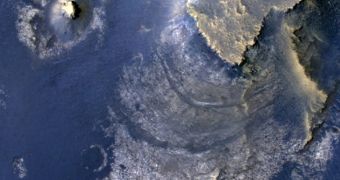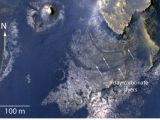The presence of water on Mars' surface at some time in the past isn't much of a debate anymore, the evidence is pretty strong. And if there was water on the surface, there was water underground as well. In fact, the biggest chance of finding life on Mars, now or in the past, lies under the surface.
Which is why evidence of a massive lake on the surface of Mars is encouraging, because that lake likely formed from water seeping in from beneath the surface.
Scientists analyzing images from NASA's Mars Reconnaissance Orbiter found clear evidence of surface water in the large McLaughlin Crater.
The crater is 92 kilometers, 57 miles across, but more importantly, it's 2.2 kilometers, 1.4 miles deep. The crater is also at the shallow end of a region stretching hundreds of kilometers or miles.
The meteorite that created it peered deep into Mars' crust making it possible for underground water to escape and flow into the crater.
This is what scientists believe happened as they found carbonate and clay minerals at the bottom of the crater which formed in contact with water. The material is thought to have been created within the crater and not pushed in from the outside.
Since there don't seem to be any outside channels leading to the crater, i.e. places from where surface water would have flowed in, and there are channels inside the crater near the level to which scientists believe the lake rose to, about 500 meters, 1,650 feet from the bottom, there is good reason to believe that the water originated underground.
"Taken together, the observations in McLaughlin Crater provide the best evidence for carbonate forming within a lake environment instead of being washed into a crater from outside," said Joseph Michalski, lead author of the paper who describes the findings, appearing in the Nature Geoscience journal.

 14 DAY TRIAL //
14 DAY TRIAL // 
